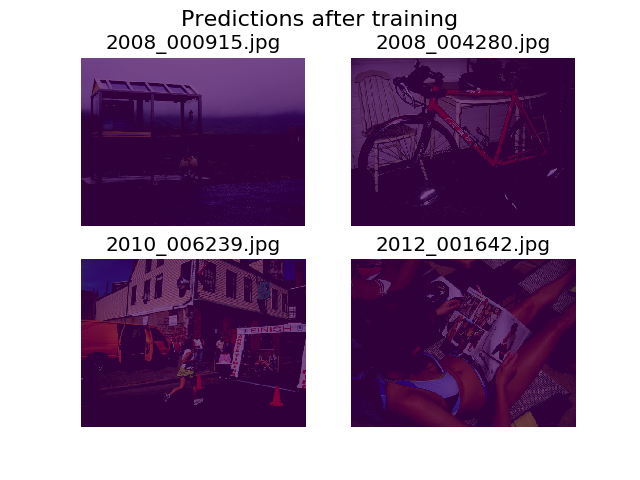I'm trying to train this Keras implementation of Deeplabv3+ on Pascal VOC2012, using the pretrained model (which was also trained on that dataset).
I got weird results with the accuracy quickly converging to 1.0:
5/5 [==============================] - 182s 36s/step - loss: 26864.4418 - acc: 0.7669 - val_loss: 19385.8555 - val_acc: 0.4818
Epoch 2/3
5/5 [==============================] - 77s 15s/step - loss: 42117.3555 - acc: 0.9815 - val_loss: 69088.5469 - val_acc: 0.9948
Epoch 3/3
5/5 [==============================] - 78s 16s/step - loss: 45300.6992 - acc: 1.0000 - val_loss: 44569.9414 - val_acc: 1.0000
Testing the model also gives 100% accuracy.
I decided to plot predictions on the same set of random images before and after training, and found that the model is encouraged to say everything is just background (that's the 1st class in Pascal VOC2012).
I'm quite new to deep learning and would need help to figure out where this could come from.
I thought that perhaps it could be my loss function, which I defined as:
def image_categorical_cross_entropy(y_true, y_pred):
"""
:param y_true: tensor of shape (batch_size, height, width) representing the ground truth.
:param y_pred: tensor of shape (batch_size, height, width) representing the prediction.
:return: The mean cross-entropy on softmaxed tensors.
"""
return tf.reduce_mean(tf.nn.softmax_cross_entropy_with_logits_v2(logits=y_pred, labels=y_true))
I am a bit uncertain on whether my tensors have the right shape. I'm using TF's dataset API to load .tfrecord files, and my annotation tensor is of shape (batch_size, height, width). Would (batch_size, height, width, 21) be what's needed? Other errors from inside the model arise when I try to separate the annotation image into a tensor containing 21 images (one for each class):
tensorflow.python.framework.errors_impl.InvalidArgumentError: Incompatible shapes: [12,512,512,21] vs. [12,512,512]
[[Node: metrics/acc/Equal = Equal[T=DT_INT64, _device="/job:localhost/replica:0/task:0/device:GPU:0"](metrics/acc/ArgMax, metrics/acc/ArgMax_1)]]
[[Node: training/Adam/gradients/bilinear_upsampling_2_1/concat_grad/Slice_1/_13277 = _Recv[client_terminated=false, recv_device="/job:localhost/replica:0/task:0/device:GPU:1", send_device="/job:localhost/replica:0/task:0/device:CPU:0", send_device_incarnation=1, tensor_name="edge_62151_training/Adam/gradients/bilinear_upsampling_2_1/concat_grad/Slice_1", tensor_type=DT_FLOAT, _device="/job:localhost/replica:0/task:0/device:GPU:1"]()]]
Thank you for your help!


